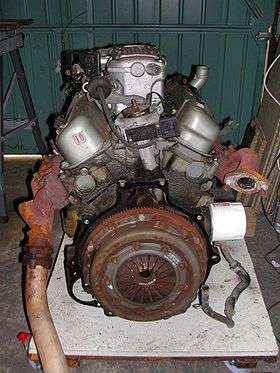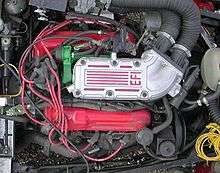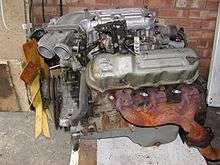Ford Cologne V6 engine
| Ford Cologne V6 | |
|---|---|
 | |
| Overview | |
| Manufacturer | Ford Motor Company |
| Also called | Ford Taunus V6 |
| Production | 1962-2011 |
| Combustion chamber | |
| Cylinder block alloy | cast iron |
| Valvetrain | pushrod overhead-valve |
| Chronology | |
| Successor | Ford Cyclone engine |
The original Ford Cologne V6 is a series of 60° cast iron block V6 engines produced continuously by the Ford Motor Company in Cologne, Germany, since 1965. Along with the British Ford Essex V6 engine and the U.S. Buick V6 and GMC Truck V6, these were among the first mass-produced V6 engines in the world.
Throughout its production run, the Cologne V6 has evolved from the engine displacements of 1.8, 2.0, 2.3, 2.4, 2.6, 2.8, 2.9, and 4.0 litres engines.[1] All except the Cosworth 24v derivative and later 4.0 litre SOHC engines were pushrod overhead-valve engines, with a single camshaft between the banks.
Originally, the Cologne V6 was installed in vehicles intended for Germany and continental Europe, while the British Essex V6 was used in cars for the British market. The Cologne and the Essex engines were not related at all. Later, the Cologne V6 largely replaced the Essex V6 for British-market vehicles. These engines were also used in the United States, especially in compact trucks.
The Cologne V6 was made to be very compatible in installation with the Ford Taunus V4 engine, having the same transmission bolt pattern, the same engine mounts, and in many versions, a cylinder head featuring "siamesed" exhaust passages, which reduced the three exhaust outlets down to two on each side. The latter feature was great for compatibility, but poor for performance. The 2.4, 2.9, and 4.0 had three exhaust ports, making them preferable.
The engine was available in both carburetted and fuel-injected forms.
1.8
The smallest version of the V6 was the 1,812 cc (1.812 L; 110.6 cu in) with a 80.0 mm (3.15 in) bore and a 60.14 mm (2.368 in) stroke. Its output was 82 hp (60 kW) and 135 N·m (100 lb·ft). Its only application was the Ford 17M P7 from 1968 to 1971.
2.0
The original displacement of the V6 was 1,998 cc (1.998 L; 121.9 cu in) with a 84.0 mm (3.31 in) bore and a 60.14 mm (2.368 in) stroke. Output was 85 hp (63 kW) and 151 N·m (111 lb·ft) or 90 hp (66 kW) and 158 N·m (117 lb·ft).
Applications:
- 1964-1967 Ford Taunus 20M (P5)
- 1967-1968 Ford 20M (P7.1)
- 1968-1971 Ford 20M (P7.2)
- 1969-1981 Ford Capri I - III
- 1970-1976 Ford Taunus TC
- 1976-1979 Ford Taunus II
- 1979-1982 Ford Taunus III
- 1975-1977 Ford Granada I
- 1977-1985 Ford Granada II
- 1982 Ford Sierra (Not available in UK models)
2.3
The first enlargement of the V6 appeared in 1967. It was the 2,293 cc (2.293 L; 139.9 cu in) with a 90.0 mm (3.54 in) bore and a 60.14 mm (2.368 in) stroke. Output was 108/114 hp (79/84 kW)(black/grey valve cover) and 176 N·m (130 lb·ft) or 125 hp (92 kW) and 187 N·m (138 lb·ft) in SuperHighCompression
- 1967-1968 Ford 20M P7.1
- 1968-1971 Ford 20M P7.2
- 1969-1974 Ford Capri I
- 1974-1978 Ford Capri II
- 1978-1985 Ford Capri III
- 1971-1976 Ford Taunus TC
- 1976-1979 Ford Taunus II
- 1979-1982 Ford Taunus III
- 1977-1979 Ford Cortina IV
- 1979-1982 Ford Cortina V
- 1972-1977 Ford Granada I
- 1977-1985 Ford Granada II
- 1982-1984 Ford Sierra I
2.6
The largest first-generation V6 was the 2,550 cc (2.55 L; 156 cu in) introduced in 1969. It had a 90.0 mm (3.54 in) bore and a 66.8 mm (2.63 in) stroke. Output was 125 hp (92 kW) and 205 N·m (151 lb·ft).
Applications:
- 1969-1971 Ford 26M
- 1970-1974 Ford Capri
- 1972-1977 Ford Granada
2.6 RS
A special high-performance version had 2,637 cc (160.9 cu in) with a 90.0 mm (3.54 in) bore and a 69.0 mm (2.72 in) stroke. With fuel injection, it produced 150 hp (110 kW) and 219,5 Nm. It was the only first-generation engine with fuel injection. Its only application was the Ford Capri RS 2600 where it was used from 1970 to 1973 when it was replaced with the RS 3100. Weslake developed a racing version of the engine, bored to 96 mm to give 2995 cc of displacement and producing in excess of 320 hp.
- Ford Capri 2600 RS from 1970 to 1973
2.8
The second-generation Cologne V6 was introduced in 1974. It displaced 2.8 L (93.03 mm bore, 68.5 mm stroke, 2,792 cc or 170.4 cu in) and used a geared camshaft design. The European version used a "siamesed" two-port exhaust manifold, similar to the one used on the V4, while the American version used three-port heads. The European approach was useful in that existing cars with the V4 engine could be upgraded with relative ease. Output was rated at 90 to 115 bhp (86 kW) for the US market and 130 to 160 bhp (119 kW) for the European market, depending on the model.
In Europe, the 2.8 was produced with carburetor (132 bhp), mechanical fuel injection (Bosch K-Jetronic, 160 bhp), and electronic injection (Ford EEC-IV, 150 bhp). Electronic injection only featured on the 2.8 Granada models for one year before being replaced with the 2.9 unit.
Tuning options are very limited with the Bosch K-Jetronic models. The siamesed inlet and exhaust ports of the 2.8 only respond well to forced induction or an overbore; normal tuning will yield only minor power results. The MFI 2.8 Cologne (Capri/Sierra 2.8i) uses a very restricted induction setup, and no open air kit is available due to this.
TVR Tasmin/280i used the Cologne 2.8 with Bosch K-Jetronic fuel injection, as did the early TVR 'S' series in 2.8 and revised 2.9 efi injection form.
Applications:
- TVR 280i/Tasmin
- TVR S1
- Ford Ranger
- Ford Bronco II
- Ford Aerostar
- Ford Pinto
- Mercury Bobcat
- Mercury Capri
- Ford Mustang II
- Ford Granada
- Ford Capri III
- Ford Sierra
- Ford ScorpioFord Scorpio
- Bandvagn 206
- Reliant Scimitar (1979 onwards)
- Panther Kallista
2.9




The 2.9 L shares the same basic design as the 2.8 L model, bar a few subtle differences. The camshaft is chain-driven rather than gear driven, so it rotates in the same direction as the crankshaft. The arrangement of the exhaust valves is different, eliminating the "hot-spot" that existed on the 2.8 L model. The cylinder heads also sport a more conventional three-port exhaust manifold. Output was rated at 160 hp (119 kW) @4600 rpm and 170ftlbs@2600rpm for the light trucks (1986-92 Ranger and 1986-90 Bronco II) and 144 hp (107 kW) @4800 rpm for the Merkur Scorpio in the US market and 150 to 160 hp (112 to 119 kW) for the European market. Bore was 93 mm (3.661 in) and stroke was 72 mm (2.835 in) for a total displacement of 2.9 L (2935 cc/177 cu in).
In Europe, this engine was commonly fitted with the Bosch L-Jetronic fuel-injection system, married to Ford's EEC-IV engine management. Because of this difference over the 2.8 L model, this version was a more popular candidate for aftermarket modification (typically turbocharging) from companies such as Janspeed and Turbo Technics.
Applications:
- TVR S2/S3(C)/S4C
- Ford Bronco II
- Ford Ranger
- Ford Sierra XR 4X4
- Ford Granada
- Ford Transit
- Merkur Scorpio
- Panther Kallista
2.9 Cosworth
A special twin DOHC (QUAD CAM) version of the 2.9 was created by Cosworth Engineering in 1991. Although it shared the same block as the standard 2.9, power output was up to 195 PS (143 kW) and torque was boosted to 203 lb·ft (275 N·m) at 4500 rpm. This engine (code BOA) was used in the Ford Scorpio Cosworth 24V. This engine configuration was only paired with an improved A4LDe automatic gearbox with partial electronic shift control. No manual gearbox was offered from the factory.
The standard Ford-issued block was machined differently to improve strength. In place of the single-cam arrangement, an endless duplex hydraulically tensioned timing chain was used to drive the overhead cams. The chain measured 2.2 m. [2] The casting and bearings for the standard underhead cam were repurposed for a shaft which drove the oil pump. Ignition was controlled by a EDIS-6 system, which would become a standard feature.
The engine was known for its substantial increase in power delivery above 4000 rpm relative to the unmodified version; in recent years, the engine has become a popular choice as a replacement engine for the Ford Sierra XR4x4 and XR4i.
An improved version of this engine (code BOB) was available in the restyled 1995 Ford Scorpio. Differences included two simplex chains with two hydraulic tensioners and the addition of a variable-length intake system called VIS. Power output was increased to 210 bhp (157 kW). This was mated to a fully electronically controlled A4LDE automatic transmission.
4.0

The 4.0 L pushrod (242/245 CID; 3958/4009 cc, with a 100.0 mm (3.94 in) bore and a 84 mm (3.3 in) stroke.) version, although produced in Cologne, Germany, was only fitted to American vehicles.[3] The OHV engine was produced until 2000 and was used in the Ford Explorer, Ford Aerostar, Mazda B4000, and Ford Ranger. Output was 160 hp (119 kW) and 225 lb·ft (305 N·m). Though some variation exists, typically 155 hp (116 kW) is quoted as horsepower for 1990-92 applications.
This evolutionary redesign of the American 2.9 solved many of the reliability issues that plagued its predecessor. A stronger cylinder head design eliminated the 2.9's common failure of cracked heads. Hydraulic roller lifters replaced the simple hydraulic lifters used in the 2.9, which were sometimes overly sensitive to oil contamination, often requiring the lifters to be replaced prematurely. However, one major design fault was not completely eliminated: Valve rockers and upper pushrod tips still received poor oil supply, resulting in eventual wear to these areas, and consequential valvetrain noise as a result of the increased clearance. Required replacement of these parts is common in older engines.
Applications:
- Ford Ranger/Mazda B-Series
- Ford Explorer/Mazda Navajo
- Cross Lander 244X
- Ford Aerostar (1990–1997)
SOHC
The SOHC version was introduced in 1997 in the Ford Explorer, alongside the original pushrod version. It features a variable length intake manifold and produces 210 hp (157 kW) and 254 lb·ft (344 N·m)f. It uses a jackshaft in place of a camshaft to drive a timing chain to each cylinder head. Three timing chains are used, one from the crank to the jackshaft, one in the front of the engine to drive the cam for the left bank, and one on the back of the engine to drive the cam for the right bank. Ford has since phased out the engine in favor of the more powerful and efficient Duratec 37.[4]
A version of the engine is used in the Land Rover LR3 and Ford Courier in Australia and Canada, producing 216 hp (161 kW) and 250 lb·ft (339 N·m) of torque at 3,000 rpm. The Land Rover version of the engine became unavailable in the United States for the 2008 model year.[5]
Applications:
- 2001–2012 Ford Ranger
- 2001–2010 Mazda B4000
- 1997–2010 Ford Explorer/Mercury Mountaineer
- 2004–2006 Ford Courier
- 2005–2010 Ford Mustang
- 2005–2009 Land Rover LR3
Turbo and supercharging
A number of companies have produced forced induction versions of the engine.
Janspeed produced single and twin turbo 2.8 and 2.9 engines.
Sprintex produced 2.8 and 2.9 supercharged engines.
Turbo Technics produced single and twin turbo 2.8 and 2.9 engines:
- 2.8 single 200 bhp (150 kW)
- 2.8 single 230 bhp (170 kW)
- 2.8 single 250 bhp (190 kW)
- 2.8 twin 280 bhp (210 kW)
- 2.9 twin 225 bhp (168 kW)
- 2.9 twin 250 bhp (190 kW)
- 2.9 twin 280 bhp (210 kW)
- 2.9 twin 323 bhp (241 kW) MINKER
Explorer Express has also developed a series of Eaton Roots type supercharger systems producing from 6 psi (41 kPa)-11 psi (76 kPa) of boost for the 4.0 engine.
A limited number of 24V BOA/BOB's have forced induction also a racing version of BOA called, BOE (naturally aspirated):
- 2.3 turbo was available in the 20M/Capri/Granada/OSI and produced 188 hp
- 2.6 Turbo was available in some cars with 207 hp
- 2.8 Turbo came later with 200 hp
An Eichberg 2.8i turbo was also available.
Capacity increases
In 1991 increased capacities for the 2.8 and 2.9 engines (3.5 and 3.7 litres, respectively), were first developed and introduced by D.P. Davies and sold by his company, VeeTech Engineering now RND Engineering in the UK. Two companies still produce large capacity conversions on the 2.8 & 2.9: Power Engineering and Specialised Engines.
Other cars using the Cologne V6
- Ford Explorer
- Ford Capri
- Mercury Capri
- Ford Consul
- Ford Granada
- Ford Cortina
- Ford Taunus
- Ford Sierra
- Ford Scorpio
- Merkur Scorpio
- Ford Transit
- Ford Aerostar
- Panther Kallista 2.8L
- Panther Kallista 2.9i
- Reliant Scimitar SE6b
- TVR Tasmin series (a.k.a. "Wedge")
- TVR S series (S1, S2, S3, S4)
References
| Wikimedia Commons has media related to Ford Cologne V6 engine. |
- ↑ "Cologne V6 engines". ford-ig-wriede.de. Retrieved 2015-07-21.
- ↑ 2.9 24V Cosworth BOA Engine Ford Service guide
- ↑ Archived December 3, 2008, at the Wayback Machine.
- ↑ Ford, Ford Power Products Catalogue. Archived December 3, 2008, at the Wayback Machine.
- ↑ "Land Rover LR3 Review ''Edmunds''". Edmunds.com. 2010-08-11. Retrieved 2011-01-06.
- Anderson, Doug. Rebuilding The Ford 4.0L Pushrod V6, Engine Builder, April 2001.
| Ford Motor Company engine timeline, North American market, 1950s–1970s — Next » | ||||||||||||||||||||||||||||||
|---|---|---|---|---|---|---|---|---|---|---|---|---|---|---|---|---|---|---|---|---|---|---|---|---|---|---|---|---|---|---|
| Type | 1950s | 1960s | 1970s | |||||||||||||||||||||||||||
| 0 | 1 | 2 | 3 | 4 | 5 | 6 | 7 | 8 | 9 | 0 | 1 | 2 | 3 | 4 | 5 | 6 | 7 | 8 | 9 | 0 | 1 | 2 | 3 | 4 | 5 | 6 | 7 | 8 | 9 | |
| 4-cylinder engines | Ford Pinto engine | |||||||||||||||||||||||||||||
| I6 engines | Flathead I6 | Thriftpower I6 | ||||||||||||||||||||||||||||
| Mileage Maker I6 | Truck I6 | |||||||||||||||||||||||||||||
| V6 engines | Cologne V6 | |||||||||||||||||||||||||||||
| Small block V8 | Flathead V8 | 351 Cleveland V8 | ||||||||||||||||||||||||||||
| Windsor V8 | ||||||||||||||||||||||||||||||
| Ford Y-block V8 | 335/Modified V8 | |||||||||||||||||||||||||||||
| Medium block V8 | FE V8 | |||||||||||||||||||||||||||||
| Big block V8 | Lincoln Y-block V8 | |||||||||||||||||||||||||||||
| MEL V8 | 385 V8 | |||||||||||||||||||||||||||||
| Super Duty V8 | ||||||||||||||||||||||||||||||